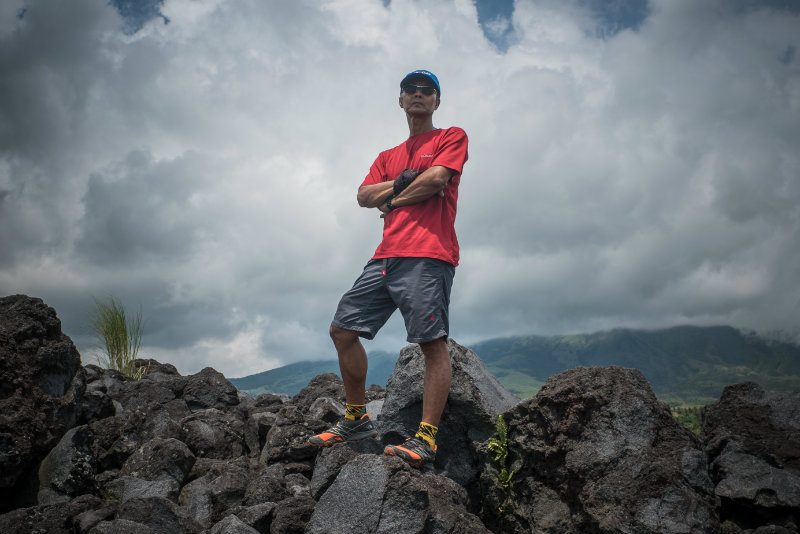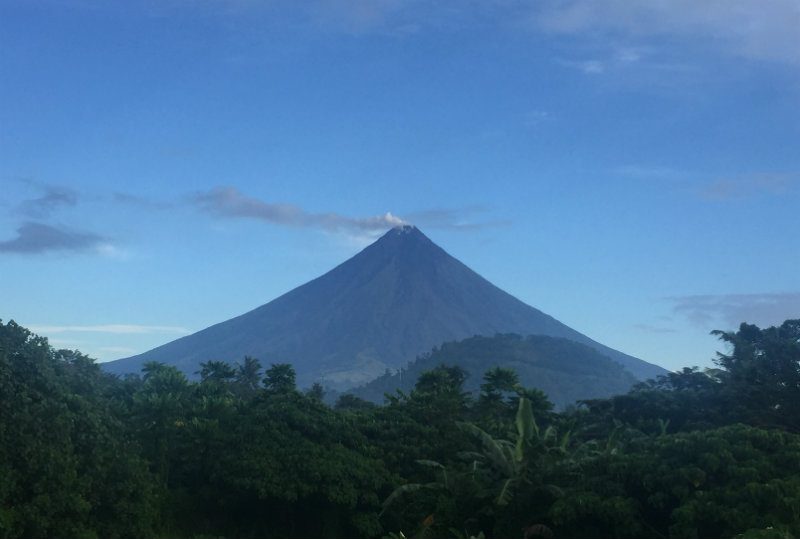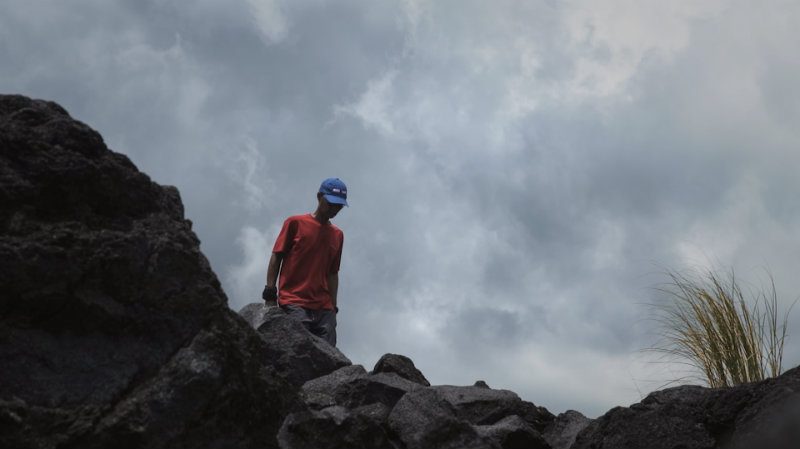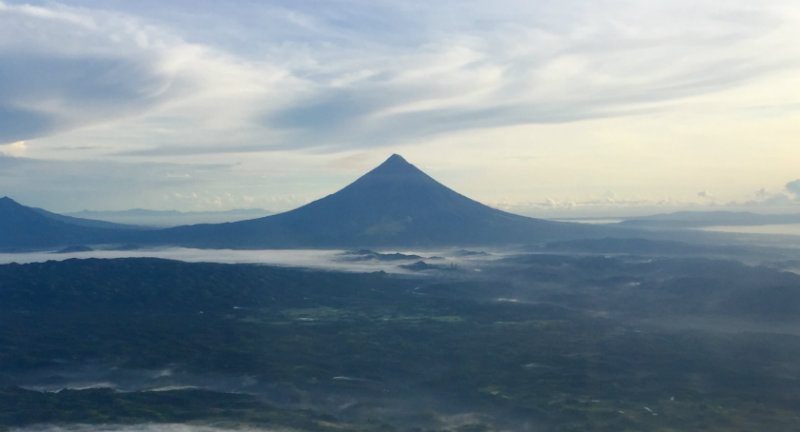SUMMARY
This is AI generated summarization, which may have errors. For context, always refer to the full article.

LEGAZPI CITY, Philippines – Like many stories of romance, theirs started with an insatiable attraction.
At an early age, George Cordovilla fell madly in love with her. Like how any hopeless romantic would, he tirelessly pursued her. Throughout many decades, his love never faltered even amid threats that were difficult to predict.
Except, George Cordovilla isn’t referring to any random girl. Instead, he fell in love with the beautiful maiden of Albay, the Mayon volcano.
“My number one advocacy is to protect the volcano that I love. I fell in love with the volcano because, every morning when I wake up, I can see the beauty in its perfect symmetry. It is very inspiring to everybody who sees her,” Cordovilla said.
He first climbed the volcano at 17 years old. Now at 56, George has lost count of the number of times he has reached the Mayon’s summit. He said he stopped counting at 300.
Tiger of Mayon
Cordovilla is known for his undying commitment to preserve the beauty and rich biodiversity of Mayon.
He does not just swoon over Mayon’s beauty. He walks the talk, too. In 2013, Cordovilla was instrumental in saving a tourist guide when the volcano had a phreatic eruption. Late in September 2017, he also led the community and local police to apprehend the group of climbers who scaled the volcano despite a ban on climbing.
His life’s worth of efforts to climb, conserve and protect the volcano later earned him the monicker “Tiger of Mayon.” For him, each of his over 300 climbs felt like the first time.
“They call me the ‘Tiger of Mayon’ because of the number of times I scaled the volcano. At the same tme, it’s a monicker. They called me that because I kind of serve as the volcano’s guardian. They know how passionate I am about climbing this volcano,” Cordovilla said.
It was Edwin Gatia, the person known as the “Tiger of Kanlaon,” who gave Cordovilla the nickname. The two are just among the pilars of the mountaineering community in the Philippines who co-founded the Montain Climbers Alliance of the Philippines. They consider themselves as “old school climbers.”
“All major mountains have been climbed by this organization. We impart our advocacy to take care of the mountain and, at the same time, we teach newbies the technicalities of becoming a tropical mountaineer,” Cordovilla said.

For Cordovilla, climbing a mountain is a balancing act of enjoying nature’s wonders and exercising responsibility. This is why, way back in 1979, he strived to become an accredited guide under the Department of Tourism (DOT), undergoing a basic mountaineering course (BMC).
In fact, Cordovilla is one of the most senior members of the Mayon Naturalist Ecoguides Inc. (Manega), the group of accredited tour guides in Mayon.
Being an accredited guide means they are required to follow the standard operating procedures before venturing out for a climb, including securing a visitor’s permit from the Department of Environment and Natural Resources and check with Phivolcs for any alert on the volcano. (#SharePH: ATV adventure at the foot of Mayon Volcano)
Seeing the province’s main attraction – the 2,462-meter-tall volcano – always leaves many tourists and residents in awe.
“It is a magnet that attracts people of all races,” Cordovilla says of the volcano.
But one should not be fooled by its beauty. Volcanologists classify Mayon as an active volcano, which means there is a constant possibility of eruption even in the absence of an alert.
This lingering threat, however, never stopped people from seeing Mayon up close. (READ: Looking back: Mayon Volcano’s most destructive eruption)
Selfless love
Becoming a tour guide, according to Cordovilla, gave him the opportunity to share the beauty of Mayon at the same time promote responsible climbing to tourists.
“I am a guide. It is also my passion to climb. I also impart what I feel whenever I climb this mountain and other volcanoes,” he said.
On May 6, 2013, Cordovilla, together with his porter guide, brought 5 Thai tourists to the summit of Mayon. They were able to reach the summit at 3 pm of the same day. As they started their descent, however, the microweather around the volcano started to change and it began to rain hard.
“Suddenly, I heard a sound that is similar to a loud exhale. It is as if the mountain was expanding. And then big rocks suddenly started falling,” Cordovilla distinctly recalled that particular climb as if it only happened yesterday.
Because of the strong rain and falling rocks, Cordovilla decided to split the team into two. After giving his porter instructions to follow, Cordovilla led the first team to go ahead, across two gullys, to Camp 2.
Night came, however, but his porter and the rest have not made it to the Camp 2, their designated meet up place. The rain was still pouring hard and Cordovilla figured that they may have lost their way. This is when he decided to call for a preemptive rescue.
When the morning came, the weather also cleared. He got a call from the rescuers who were at the foot of the volcano, relaying the good news that they found his porter and the Thai tourist a few meters behind where they were. Cordovilla and his team then proceeded to descend the volcano.
“After 10 minutes, that is when it felt like the water started boil. We heard a loud whistle, followed by a loud explosion. Boom!,” he recalled.
It began raining rocks – big and burning boulders.
The small phreatic event – caused by the heating of water by the magma underneath the volcano’s crater, sending steam, water, and volcanic material out – lasted 73 seconds but it was enough to separate and delay the descent of the other team.

A few minutes later, the porter and the other tourists were able to reach the foot of the volcano – except for one: the Thai tourist named Boonchai Jattupornong.
The next day, Cordovilla led the search and rescue for the missing tourist. Fortunately, they found him alive on the other side of the gully. He lost his helmet and fractured his arm.
“He said, when the volcano erupted, he went the other way and got separated from the rest of the team. He rolled and hit his arm. He ended up on a slope. That is where he stayed,” Cordovilla said.
Bringing him to safety took more than 36 hours, according to him.
The National Disaster Risk Reduction and Management Council (NDRRMC) said 5 mountain climbers died after being hit by rocks cascading down the slopes of the volcano due to the phreatic eruption. Four of the casualties were Germans, while the fifth was their Filipino tour guide, Jerome Berin.
Volcano’s vanguard
“That incident prompted the government to ban climbing because they said it is unpredictable,” Cordovilla shared.
Despite the ban, some groups still organized backdoor climbs at the Mayon volcano. Backdoor mountaineering, accordigng to Cordovilla, refers to climbs organized at mountains where climbing is prohibited.
“The problem is, while there is an ordinance, there is a problem with enforcement. Even the DENR lacks the personnel to guard the volcano and patrol existing trails,” Cordovilla said.
On September 25, Cordovilla was told about the lights villagers saw at the volcano. He then quickly told local officials about the climbers who ascended the volcano despite the ban.
“We mobilized the village together with local police from Malilipot. They apprehended the group,” Cordovilla said.

The group were made up of 31 mountaineers who came all the way from Manila. More than anything, Cordovilla expressed his dismay over the incident.
“Although we belong to the same group, others carry a different advocacy. They guide because they consider this as a business. They are not as passionate about taking care of the mountain,” he said.
For aspiring mountaineers
When Cordovilla started mountain climbing in the late 1970s, only few people would join them. But, recently, they have seen a spike in the number of people climbing summits.
“Climbing is trending. During that time, we wanted to promote mountain climbing but nobody heeded to us. With Facebook, mountaineering suddenly trended,” he said.
While he is happy that mountaineering is attracting old and young souls alike, Cordovilla hopes to teach more poeple how to take care of the volcano.
For aspiring mountaineers, he recommends them to take a BMC to learn what it takes to become tropical mountaineer. He also discouraged millennials from taking “buwis-buhay” (life-threatening) shots at summits of mountains.
“A lot of people are now climbing mountains. They would post their pictures, selfies, and life-threatening shots. Many of those who climb just climb to take a photo which they can post. I hope before they do that, they also think about the possible impact when something wrong happens,” Cordovilla said.
Ultimately, he wishes that people who climb share his love and passion for taking care of mountains.
“There is constant courtship. You will always pursue this beautiful maiden of Albay. The more you are challenged, the more you would be encouraged to pursue her,” Cordovilla said. – Rappler.com
Add a comment
How does this make you feel?
There are no comments yet. Add your comment to start the conversation.